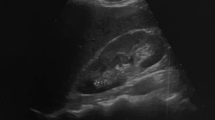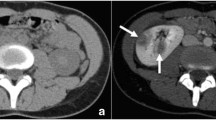Abstract
Purpose
To analyze with diffusion-weighted magnetic resonance imaging (DW-MRI) the evolution and progress to resolution of acute pyelonephritis (APN) foci over a period of 3 months after onset.
Methods
30 women (age 22–51 years) with clinical, laboratory (white blood cell and C-reactive protein), and DW-MRI (4b-values 0, 50, 600, 1000 s/mm2) diagnosis of APN were prospectively enrolled. Two double-blinded radiologists evaluated the number of APN foci, and for each of them dimension (D), absolute diffusion coefficient (ADC), and its ratio R to the ADC of unaffected parenchyma. Signature of radiological recovery was focus no longer visible (DW−) and ADC of its site not inferior to the ADC of the unaffected parenchyma, i.e., R ≥ 0.9. Clinical and DW-MRI follow-ups (FU) were performed at 1 and 3 months.
Results
At the acute stage (t 0), 187 APN foci were found, with ADC0 = 1.3 ± 0.2 × 10−3 mm2/s, R 0 = 0.65 ± 0.12, and D 0 = 14 ± 7.5 mm. By the 1-month FU (t 1), all patients had no symptoms and physiological laboratory values; despite this, only 80 (43%) foci were solved, increasing to 138 (74%) by at the 3-month FU. The ROC curve (AUC ≥ 0.80) identified R 0 ≤ 0.6 and D 0 > 15 mm as forecast of slow radiologic resolution. About 80% of foci unsolved at 1 month but with R 1 ≥ 0.8 and D 1 ≤ 10 mm reached solution at 3 months.
Conclusions
DW-MRI recovery of APN foci does not always coincide with clinical recovery. The evolution of an APN focus is shaped by its initial values R 0 and D 0. About half of the foci still visible at 1 month reached radiological resolution in the two following months.




Similar content being viewed by others
References
Neal DE (2008) Complicated urinary tract infections. Urol Clin North Am 35(1):13–22
Czaja CA, Scholes D, Hooton TM, Stamm WE (2007) Population-based epidemiologic analysis of acute pyelonephritis. Clin Infect Dis 45(3):273–280
Das CJ, Ahmad Z, Sharma S, Gupta AK (2014) Multimodality imaging of renal inflammatory lesions. World J Radiol 6(11):865–873
Brenner DJ, Hall EJ (2007) Computed tomography—an increasing source of radiation exposure. N Engl J Med. 357(22):2277–2284
Fontanilla T, Minaya J, Cortés C, et al. (2012) Acute complicated pyelonephritis: contrast-enhanced ultrasound. Abdom Imaging 37(4):639–646
Martina MC, Campanino PP, Caraffo F, et al. (2010) Dynamic magnetic resonance imaging in acute pyelonephritis. Radiol Med 115(2):287–300
Piccoli GB, Colla L, Burdese M, et al. (2006) Development of kidney scars after acute uncomplicated pyelonephritis: relationship with clinical, laboratory and imaging data at diagnosis. World J Urol 24(1):66–73
De Pascale A, Piccoli GB, Priola SM, et al. (2013) Diffusion-weighted magnetic resonance imaging: new perspectives in the diagnostic pathway of non-complicated acute pyelonephritis. Eur Radiol 23(11):3077–3086
Piccoli G, Colla L, Maass J, et al. (2005) Acute pyelonephritis: a new approach to an old clinical entity. J Nephrol 18(4):474–496
Faletti R, Cassinis MC, Gatti M, et al. (2016) Acute pyelonephritis in transplanted kidneys: can diffusion-weighted magnetic resonance imaging be useful for diagnosis and follow-up? Abdom Radiol N Y 41(3):531–537
Faletti R, Cassinis MC, Fonio P, et al. (2013) Diffusion-weighted imaging and apparent diffusion coefficient values versus contrast-enhanced MR imaging in the identification and characterisation of acute pyelonephritis. Eur Radiol 23(12):3501–3508
Rathod SB, Kumbhar SS, Nanivadekar A, Aman K (2015) Role of diffusion-weighted MRI in acute pyelonephritis: a prospective study. Acta Radiol 56(2):244–249
Vivier P-H, Sallem A, Beurdeley M, et al. (2014) MRI and suspected acute pyelonephritis in children: comparison of diffusion-weighted imaging with gadolinium-enhanced T1-weighted imaging. Eur Radiol 24(1):19–25
Aoyagi J, Odaka J, Kuroiwa Y, et al. (2014) Utility of non-enhanced magnetic resonance imaging to detect acute pyelonephritis. Pediatr Int 56(3):e4–e6
Padhani AR, Liu G, Mu-Koh D, et al. (2009) Diffusion-weighted magnetic resonance imaging as a cancer biomarker: consensus and recommendations. Neoplasia N Y N 11(2):102–125
Author information
Authors and Affiliations
Corresponding author
Rights and permissions
About this article
Cite this article
Faletti, R., Gatti, M., Bassano, S. et al. Follow-up of acute pyelonephritis: what causes the diffusion-weighted magnetic resonance imaging recovery to lag clinical recovery?. Abdom Radiol 43, 639–646 (2018). https://doi.org/10.1007/s00261-017-1242-0
Published:
Issue Date:
DOI: https://doi.org/10.1007/s00261-017-1242-0




